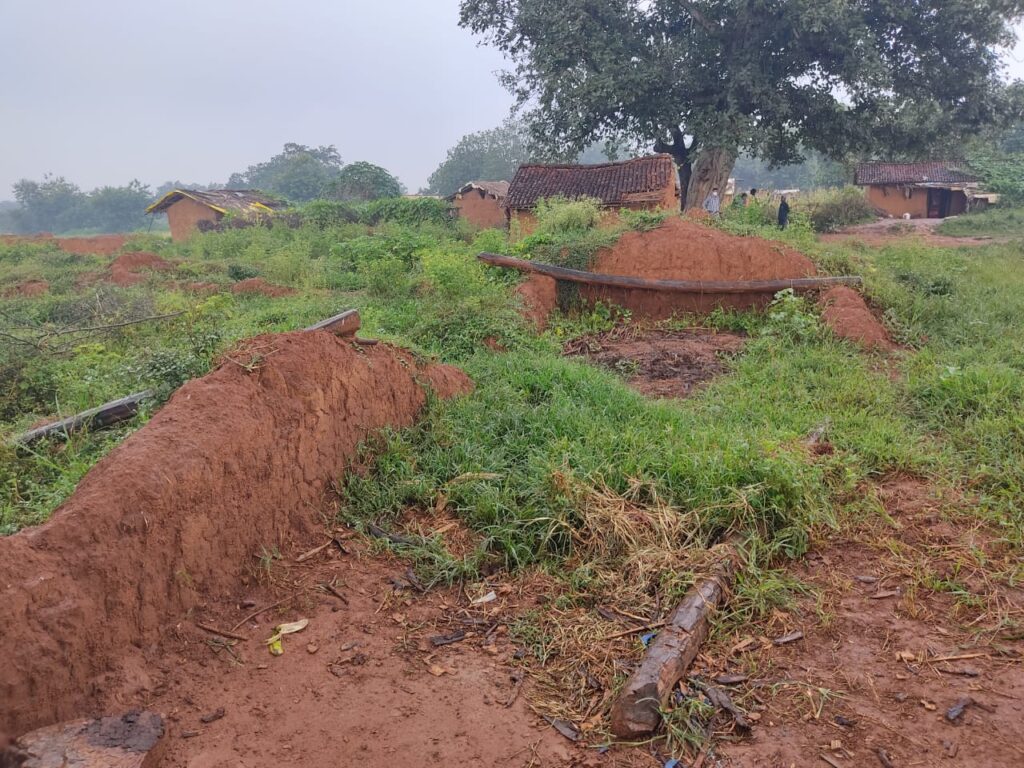Fifty-five-year-old Kuleshwari Devi’s eyes hold the pain of losing one’s home. The tired lines on her face bear witness to the hard life she has led in Adhaura, a predominantly tribal village located inside the Kaimur Wildlife Sanctuary in Kaimur district of South Bihar, bordering eastern Uttar Pradesh. Devi, a widow, has three sons whose only source of livelihood is farming.
Since April this year, her life, and that of her sons, has been thrown topsy-turvy. And the reason is a proposed tiger reserve in Kaimur, also known as Bhabua, about 600 kilometres (km) from the state capital of Patna.
In Adhaura block of the district, where Devi’s hut and village is located, 108 villages out of the total 131 villages are expected to fall under the proposed tiger reserve. This may lead to the displacement of around 50,000 indigenous people who claim to be dwelling in the local forests for generations. Devi informed Gaon Connection that officials of the forest department had in April brought down her mud house and also destroyed their crops.
“The forest officials said we don’t have permission to live in the forest area. They planted saplings in our living area, and claimed it was a plantation drive,” Devi told Gaon Connection. She showed the stone demarcations made by forest officials, disallowing people in the area. “This is the only place I know. This is my home. Where will I go?” she asked.
Devi is not sure of the motive behind the plantation drive and razing of her hut, but has heard ‘rumours’ that a tiger reserve is coming up in the area. For some time now, there’s been an undercurrent of tension among forest dwellers over the proposed tiger reserve at Kaimur.

The Bihar government has been planning to develop the Kaimur Wildlife Sanctuary into a tiger reserve, because the only such protected area in the state, Valmiki Tiger Reserve, is fast nearing saturation. The proposal for a new tiger reserve in Kaimur was cleared by the state government in August 2019.
“We are sending the project to the National Tiger Conservation Authority for approval. Kaimur Sanctuary is spread across one-thousand-seven-hundred-eighty-four square kilometers and the entire area will be declared as a tiger reserve,” Surendra Singh, Conservator of Forest Wild Life, Bihar government, confirmed with Gaon Connection.
“The conditions are very favourable in Kaimur Wildlife Sanctuary for tigers. It has a dense forest and is linked to the tiger reserves in Uttar Pradesh and Madhya Pradesh,” Dipak Kumar Singh, state principal secretary, environment, forest and climate change, told Gaon Connection.
The fear of losing their ancestral homes and lands has sparked protests among the local inhabitants, with some recent protests turning violent. During one such protest on September 10 and 11, three people were injured in firing and some during a lathicharge by police, villagers alleged.
These protests take a special meaning as three-phase polls to the 243 seats of the Bihar legislative assembly have recently been announced, and the villagers have decided to boycott the elections.

A second tiger reserve in Bihar
Of the total 1,784 square kilometres (sq km) of the Kaimur wildlife sanctuary, about 400 sq km falls in the Vindhya Range, which starts from Western Gujarat and extends till the Chota Nagpur Plateau in Jharkhand. In Bihar, it passes through Kaimur district.
The proposal to develop Kaimur as a tiger reserve gained momentum in 2017, after the then Kaimur divisional forest officer (DFO) Satyajeet Kumar sighted two tigers, saw their pug marks and also the carcasses of animals they had preyed on. The very next year, in 2018, a proposal for a tiger reserve was sent to the Bihar government by the Kaimur DFO. Following this, officials from the environment, forest and climate change department visited the sanctuary to see if conditions were favourable for tigers. In March this year, there was another tiger sighting.
If the tiger conservation authority approves the proposal of the Bihar government, a team will make a ground visit, following which the Union environment ministry will step in and declare it as a tiger reserve if it meets conditions.

Fear factor
The Kaimur Mukti Morcha, a local organisation mainly consisting of tribal people from the Kaimur hill region fighting for indigeneous community rights, has been mobilising villagers against the possible displacement of local dwellers due to the proposed tiger reserve. “Historically, these communities have peacefully co-existed with wildlife. Earlier, due to reduced forest cover, wildlife migrated. Now, they want to displace tribal people to bring back the tigers,” Raja Lal Singh Kharwar of the Kaimur Mukti Morcha told Gaon Connection.
Members of the morcha claimed that people in Ruiya village in Adhaura block had already been forcibly displaced by the forest department and police during the lockdown. On being questioned, principal secretary Singh confirmed to Gaon Connection that some encroachments had been freed following a Patna High Court order of September 2017 because “people were illegally cultivating on government land inside the sanctuary”.
During a protest against the proposed tiger reserve by the local people, on September 10 and 11, some protesters locked the gate of the forest department’s local office in Adhaura region after officials refused to speak to them. In the scuffle, it is alleged, a forest guard opened fire. “Three people were injured. However, none of them was critical and they underwent treatment at the primary health centre just a few metres away from the protest site,” said Pramukh Singh Shikshak, a villager from Jharpa inside the sanctuary, who was also part of the protests. “The buckshot hit the upper portion of my left ear,” said Prabhu from Adhaura village, one of those injured.

On September 11, police carried out a lathicharge on the protestors at the site opposite the Adhaura block office where around a thousand villagers had gathered, and brought their tent down. “Ours was a peaceful protest. I pleaded with them saying they cannot beat us like this,” said Milki Devi of Bahabar of Adhaura block, showing Gaon Connection her swollen hand. “The forests have been our livelihood since ages. If they don’t allow us to gather firewood, graze our livestock and collect tendu leaves from the forest, how will we survive?” she asked.
Kaimur superintendent of police Md. Dilnawaz Ahmed refuted allegations of firing on protestors, and told Gaon Connection that he had video evidence of the incident. He claimed that firing began from the protestors. “In defence, we fired in the air. We did not fire at the protesters. We first tried to calm them but it didn’t work. A few more arrests will be made in the case,” he said. Meanwhile, station house officer of Adhaura Police Station, Amod Kumar informed Gaon Connection that seven people had been arrested on charges of rioting and ransacking of property. “They ransacked the forest department’s office and locked the gate,” he said.

Forest rights
The villagers’ apprehensions regarding the proposed tiger reserve have been fuelled by the actions of the forest department and police, who allegedly knocked down their settlements and implicated villagers for chopping firewood. They have also been prevented from collecting tendu leaves, a major source of income.
Villagers claim they have a right over their forests, something which is also guaranteed under The Scheduled Tribes and Other Traditional Forest Dwellers (Recognition of Forest Rights) Act, 2006, commonly known as the Forest Rights Act, or FRA. The 2006 Act gives forest dwellers the right to “hold and live in forest land under individual or common occupation for habitation or for self-cultivation for livelihood by a member or members of a forest dwelling Scheduled Tribe or other traditional forest dwellers.” and “right of ownership, access to collect, use, and dispose of minor forest produce which has been traditionally collected within or outside village boundaries”.
However, forest officials fear that when people live in the deep forests, which is also the territory of big cats, human-wildlife conflicts might increase. “If people live within the area that falls under the tiger reserve, there are increased chances of conflict,” a forest official associated with the Valmiki Tiger Reserve told Gaon Connection on condition of anonymity. However, till date, there have been no reported incidents of human-wildlife conflict in Kaimur; only livestock have been attacked.
Kharwar of the Kaimur Mukti Morcha is afraid the proposed Kaimur tiger reserve will go the way of Betla Tiger Reserve in Jharkhand’s Palamu. “All the villages that fell under the reserve area were displaced; it was declared an uninhabited area,” he claimed. Citing the Forest Rights Act, Kharwar said, “According to the act, even a plantation drive in the forest requires approval from the gram sabha, but these rules have been deliberately violated in the Adhaura block.”
Kharwar, along with six other people have been booked under various sections of the IPC and under Section 27 of The Arms Act, 1959 for unlawful gathering, among others. He has since then been in hiding, village sources confirmed.

Threatening to boycott the upcoming Bihar legislative assembly elections, protesting villagers are demanding a rollback of the proposed tiger reserve at Kaimur. Their other demands include administrative reorganisation of Kaimur hills and inclusion of the same under Schedule V, implementation of PESA (Panchayat Extension to the Scheduled Areas) Act 1996 in the region, roll back of the draft Indian Forest (Amendment) Bill of 2019 and immediate implementation of the Forest Rights Act, 2006.
Meanwhile, Vikash Ahlawat, Kaimur DFO has assured the villagers there would be no displacement. “There are no such restrictive rules for a tiger reserve. As per the existing Wildlife Protection Act and Indian Forests Act, a tiger reserve is basically notified symbolically. This facilitates additional funds from the central government for developing the area,” he told Gaon Connection. “It has nothing to do with villagers residing in the area. The fear about communities being displaced is the result of rumor mongering by vested groups,” he added.
To counter the ‘misinformation’, the forest department is planning a series of talks with the villagers soon. “The Centre is yet to notify Kaimur as a tiger reserve. It’s a long process that involves data verification and habitat suitability,” he said.
Will the growl of tigers in Kaimur mean the end of interdependence of local tribal communities on their forests?


















